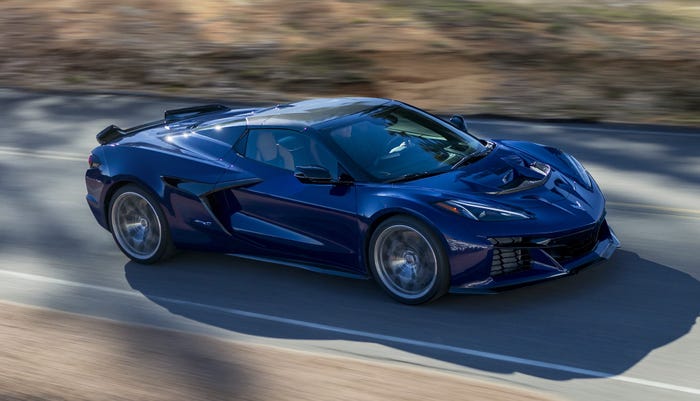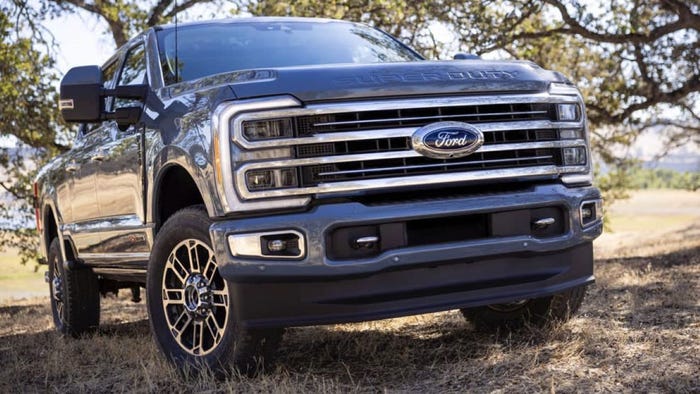Toyota Tundra Takes Another Run at Fullsize Truck Segment
Trying yet again to break the stronghold on fullsize pickup trucks held by Detroit brands, Toyota reveals the all-new ’22 Tundra pickup, set to begin production in November at its plant in San Antonio, TX, and reaching first customers in December.

Tom Murphy
2022 Toyota Tundra Limited trailer
2022 Toyota Tundra TRD SR5 rear driver
2022 Toyota Tundra closeup sheetmetal crease
2022 Toyota Tundra TRD Pro elbow button to release tailgate
2022 Toyota Tundra TRD Pro SMC composite bed
2022 Toyota Tundra TRD Pro eng bay
2022 Toyota Tundra knurled volume motorcycle clutch
2022 Toyota Tundra 1794 real wood walnut veneer
2022 Toyota Tundra Ltd interior flash
2022 Toyota Tundra 1794 IP color accents
2022 Toyota Tundra Platinum blue
2022 Toyota Tundra Ben Jimenez look back
2022 Toyota Tundra reach across touchscreen
2022 Toyota Tundra red 2nd row
2022 Toyota Tundra 1794 2nd row seats
2022 Toyota Tundra 1794 profile
2022 Toyota Tundra 1794 grille
2022 Toyota Tundra TRD Pro main stage
2022 Toyota Tundra Frisco event
2022 Toyota Tundra underbody rear suspension
Mike Sweer transfer case chain. new Tundra chain in left hand. competitor in right
2022 Toyota Tundra Ltd from 2nd row
2022 Toyota Tundra Ltd gray 2nd row
2022 Toyota Tundra Ltd perforated seat
2022 Toyota Tundra TRD steering wheel
2022 Toyota Tundra TRD Pro white
2022 Toyota Tundra console open prototype
2022 Toyota Tundra console prototype
2022 Toyota Tundra TRD Pro IP
2022 Toyota Tundra TRD Pro IP
____________________________________________________________________
This represents Toyota’s third generation of the Tundra, which first arrived in 1999 and followed the T-100 pickup, which had been available in the U.S. starting in 1993.
The ’22 Tundra springs from Toyota’s new F1 Platform engineered to underpin other body-on-frame vehicles such as the Land Cruiser and Lexus LX SUVs. It is not clear if the Toyota Sequoia, which arrived in 2000, was redesigned for 2008 and has shared its architecture with the Tundra, also will switch to the new platform.
The Tundra will no longer offer the V-8, replaced by a twin-turbo 3.5L i-FORCE V-6 rated at 389 hp and 479 lb.-ft. (649 Nm) of torque as the base engine. That twin-turbo V-6 also will be offered as a 400V i-FORCE MAX full hybrid rated at 437 hp and 583 lb.-ft. (790 Nm). A new 10-speed automatic will be standard with both powertrains. The automaker expects 75% of models to sell with the non-hybrid powertrain.
Two four-door cabs will be offered. The Double cab comes with a 6.5-ft. (1.9-m) or 8-ft. (2.4-m) bed, while the CrewMax can be had with a 5.5-ft. (1.6-m) or 6.5-ft. bed. Until now, CrewMax was only available with the 5.5-ft. bed.
The new bed is made of aluminum-reinforced composite, under which Toyota carries over the solid rear axle of the previous Tundra. Leaf springs at the rear have been replaced with coil springs for better ride and handling.
Inside, the Tundra interior was designed to feel “clamped together” for rugged durability and to accommodate different lifestyles. While a larger percentage of Ford, General Motors and Ram pickups are used for work, Toyota’s Tundra has a broader following for lifestyle and recreational purposes.
An 8-in. (20-cm) multimedia touchscreen will be standard, while an all-new 14-in. (36-cm) display screen will be available, sitting horizontally across the instrument panel and providing access to infotainment features and vehicle settings. Directly in front of the driver will be a standard 4.1-in. digital multi-information screen or the available 12.3-in TFT display with digital gauge clusters.
Both Toyota and Nissan have come up short in repeated efforts to compete more directly with Detroit fullsize pickups. Through July of the ’21 model year, Toyota sold 76,254 Tundras and Nissan 24,812 Titans, according to Wards Intelligence data. For context, Ford sold 504,450 F-Series pickups, Chevrolet sold 463,118 Silverados, Stellantis sold 456,856 Rams and GMC sold 216,783 Sierras.
About the Author(s)
You May Also Like


_(2).jpg?width=700&auto=webp&quality=80&disable=upscale)


